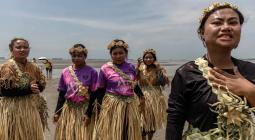No crops, no brides: how rising seas are killing India’s coastal villages
As the sea inundates Odisha’s coastline, livelihoods have withered with the harvest and weddings are a rarity as young women refuse to move to areas where they see no future
In Udaykani, a coastal village in the east Indian state of Odisha, the walls of houses were once adorned with the marriage motifs of conches and shehnais, an oboe-like instrument played at weddings, considered auspicious for bride and groom. Today, the designs have faded. The village, once a hub of joyous celebrations, has not welcomed a bride in more than a decade.
With the sea on one side and fields on the other, Udaykani, along with neighbouring Tandahar village, was hit hard by a super-cyclone, the most intense ever recorded in the northern Indian Ocean, that lashed the state 25 years ago. Along with the growing environmental volatility of the Bay of Bengal over the years, it has meant a rise in soil and water salinity and subsequent loss of agricultural land, livelihoods and marriage prospects.
“When the soil turned salty, our crops shrivelled,” says Vaidehi Kardi, 64, a Tandahar resident. “Gradually, the water too turned salty and our lives withered. It has become difficult to get our sons married. Everyone feels our village is not safe any more.”
With its 4,700-mile (7,500km) coastline, the Indian subcontinent is exposed to nearly 10% of the world’s cyclones, according to India’s National Disaster Management Authority. Most form over the Bay of Bengal and strike the eastern coast. The Bay of Bengal records four times as many cyclones as the Arabian Sea on India’s western coast. Between 2020 and last June nine cyclones hit the Bay of Bengal.
Odisha state has recorded 28% erosion along its 280-mile coastline. The state assembly heard last March that 16 villages in the state had disappeared under the sea and 247 other villages face the same fate as sea levels rise.
“It took us a long time to recover from the devastation after the super-cyclone [of 1999],” says Budheswar Kardi, 74, of Udaykani. “Our houses were completely destroyed, and most of us lost our agricultural land. The sea had moved inward so we relocated farther inland. We tried to gradually revive our lands but without much success. Now it feels like the sea is moving inwards every year.”
Arjun Pradhan, 58, has been looking for a bride for his son Abhijeet for five years. Four years ago he urged him to move to a city. “There was a time when men in our village got married by the age of 20 or 21,” he says. “Today, we have bachelors in their 30s who are yet to find a suitable match.
“I asked my son to migrate, not just to find a job but also a wife. We usually have certain restrictions when it comes to matrimonial alliances, but I don’t wish to impose any on my son. I want him to be well settled.”
It is not just marriage prospects. With the increasing soil salinity making water undrinkable, even friends and relatives are loath to visit. “Anyone who comes to visit us never stays the night,” says Kanchan Swain, 50, from Tandahar. “For one, we don’t have water that’s fit to drink. Even bathing is out of the question for visitors, who fear skin ailments.”
The villagers have to barter their grain or oil for drinking water from villages 10 miles away.
The salinisation of farmland is one of the most pressing environmental concerns. According to a study by the UN Food and Agriculture Organization more than 833m hectares of soil worldwide are already salt-affected, as is 10% of farmland, while some estimates suggest high salinity affects a third of irrigated agricultural land, with the figure increasing by 10% a year.
As farmland succumbs to the rising levels of salinity, traditional livelihoods hang in the balance. “What is left in the village for us to continue staying here?” asks Kardi.
“We have practised agriculture for generations, but today the land fails to yield. What option do we have other than to send our children away?”
Coastal villages are now home to mostly elderly men and women, left behind to tend to their land as the young people move away. Although neither jobs nor life partners are easy to come by even after migrating.
“My work here is not permanent,” says Abhijeet Pradhan, who moved to Hyderabad. “I work at a hotel as a waiter. I have switched three jobs in the last two years; whenever I am out of work, I return home. Who would agree to marry someone with such an uncertain future?”
A 32-year-old man from Udaykani, who did not want to be named, said he had been rejected four times by women who his family approached.
“Every prospective bride who visited my home was apprehensive about her future,” he says. “My parents have asked me to find a girl and get married in Chennai, where I’m currently working. They’re scared that if she or her family visit our village, they might refuse too.”
The parents and grandparents of Satya Kardi, 27, from Tandahar, also asked him to find a bride where he works. “But I have yet to make up my mind about whether I want to get married to someone with so many cultural differences and so far away from home,” he says. “Also, how can I sustain a family – wife, parents, younger siblings – on a meagre salary of 17,000 rupees [£162] a month?”
Kardi’s father, Jagannath, 53, reminisces about flourishing fields and abundant harvests. “We tried to revive our crop [yields] but the salinity had taken its toll,” he says. “Our crops never grew to their full capacity. The vegetables we cultivated attracted pests. We could barely manage to harvest enough for our own consumption, let alone sell the produce to earn a living.”
Udaykani and the other nearby villages once had wells, aquifers that were replenished and boreholes for irrigation but repeated cyclones damaged all of them, rendering the groundwater saline. Since then, villagers have relied on rain-fed agriculture, with the major crop being rice. This means the harvest and revenue vary from year to year depending on the rainfall and soil condition.
“The impact of climate change has become gradually visible in these villages, prompting the forest department to plant casuarina forests to mitigate the impacts of sea ingression,” says NA Ansari, a social activist in the region and owner of a community radio station disseminating information on the climate crisis. “But there has not been a proper assessment yet of the damage, and impending consequences, to help these villages.”
Cover photo: Budheswar Kardi tills and sows seeds on his land. The farmers of Udaykani are trying to revive their fields, he says, but with little success.





